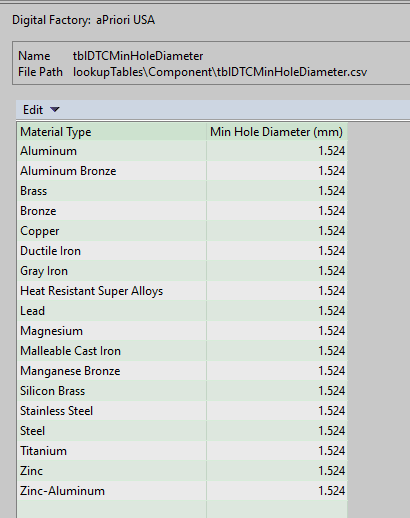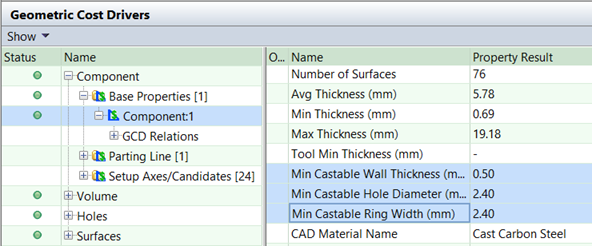aPriori 2022 R1 SP1 provides a set of enhancements to the Casting - Investment, Casting - Die, and Casting - Sand process groups. The Casting - Investment manufacturing process model was further enhanced to improve the accuracy of manufacturing operations assigned to the various part features, the Design for Manufacturability (DFM) feedback, and the cost estimates.
- Manufacturability Property for the Casting-Investment Process Group
- Improved Manufacturing Operation, Cycle Time, and Material Utilization Estimates for Investment Casting Parts
- Material-Specific Geometry Extraction Enhancement for the Casting - Die Process Group
- Improved Performance for the Casting - Sand Process Group
- Improved Selection of Secondary Machining Process for Castings
Manufacturability Property for the Casting-Investment Process Group
Cost hole and ring features that fully cast, fully machined, or both investment cast and machined.
Prior to this release, for the Casting-Investment process group, aPriori Professional determined whether a hole or ring Geometric Cost Driver (GCD) is fully cast or fully machined based on the size or wall thickness of the GCD. Now, based on the size or wall thickness of the GCD and the material of the part, aPriori Professional determines whether Simple Hole, MultiStep Hole, and Ring GCDs are fully cast, fully machined, or first investment cast and then machined.
Note: aPriori Professional provided this enhancement for the Casting - Die and Casting - Sand process groups in release 2022 R1.
The new Manufacturability property for Simple Hole, MultiStep Hole, and Ring GCDs indicates which of these manufacturing processes is used to make the GCD:
- CAST
- MACHINED
- CAST_AND_MACHINED
The based on these three criteria:
- Diameter (Simple Hole) or Width (Ring)
- Wall Thickness around the Simple Hole or Ring
- Material
If the diameter or width of the GCD is too small, then Manufacturability is set to MACHINED. If the Wall Thickness is too small, then Manufacturability is set to CAST_AND_MACHINED. Otherwise, Manufacturability is set to CAST.
Note: The Manufacturability property is also displayed for Keyway and AxiGroove GCDs, but always has a value of MACHINED.
The thresholds for GCD size and wall thickness which drive the automated Manufacturability determination are specified in the lookup tables tblDTCMinHoleDiameter and tblDTCWallThickness. The specific threshold values vary by part Material Type, as shown in these figures.
Figure: tblDTCMinHoleDiameter
Figure: tblDTCWallThickness
For convenience, aPriori displays the castability threshold values that are used to analyze a part as properties of the Component GCD (Min Castable Wall Thickness, Min Castable Hole Diameter, and Min Castable Ring Width):
Figure: Geometric Cost Drivers
If you do not agree with aPriori's determination of how a specific GCD is manufactured, you can override the Manufacturability property and set it to the desired value. Or, if appropriate, your Digital Factory manager can adjust the thresholds in the lookup tables to better match your expectations. This would affect the automated analysis of all parts.
If you override the Manufacturability property for a GCD, aPriori Professional re-extracts the GCD when the part is next costed in order to re-calculate information, such as part thickness measurements, that can be affected by the override. For example, the thickness measurements can change if a GCD is assumed to be present in the raw casting rather than machined subsequently. In some cases, changing the manufacturability property can significantly affect Maximum Thickness and Average Thickness values reported in the Design Guidance displays. For example, if a large-diameter boss feature is set to MACHINED (fully machined) instead of CAST (fully cast), aPriori now computes the thickness of that feature assuming it is cast as a solid cylinder, with the interior hole being machined subsequently.
Note: The Manufacturability property is also displayed for Keyway and AxiGroove GCDs, but always has a value of MACHINED.
The Manufacturability property replaces the Is Castable property, which was used in previous releases of aPriori Professional.
Note: To fully restore the behavior of the previous release, set the site variables isCastMachinedExtractionEnabled and enableMaterialTypeGCDExtraction to false.
Improved Manufacturing Operation, Cycle Time, and Material Utilization Estimates for Investment Casting Parts
Better estimate the manufacturing approach and cycle time and material required to create small features and thin-wall conditions.
aPriori now assigns more appropriate and accurate casting and machining manufacturing operations to Simple Hole GCDs and Ring GCDs, based on the geometric manufacturability assessment of these GCDs (as described by Casting Enhancements as well as other considerations such as machine tool accessibility. GCDs that have a Manufacturability value of CAST will continue to be assigned as Cast or Coring operations. GCDs that have a Manufacturability value of MACHINED will be assigned only machining operations and no casting operations, meaning they are assumed to be fully machined out of the net-shape cast geometry. GCDs with a Manufacturability value of CAST_AND_MACHINED are generally assigned a sequence of both machining and casting operations. aPriori Professional now also more accurately estimates the amount of material assumed to be present in the raw casting, prior to any machining operations.
For example, a thin-walled Simple Hole that is assessed as CAST_AND_MACHINED is assumed to be cast with a greater wall thickness than as modelled in the finished part (that is, one that meets the recommended minimum castable wall thickness threshold for the part's material). Rough machining operations then are assigned to remove the additional material to produce the finished hole diameter. The specific type of rough machining operation assigned depends on the selected secondary machining process routing (for example, a Simple Hole might be assigned Rough Milling on a mill and Rough Turning on a lathe) and the GCD type (for example, Ring GCDs may be assigned Rough Turning or Plunging based on feature dimensions and location).
When it assigns manufacturing operations, the cost model also considers some additional criteria beyond the geometric Manufacturability value for a GCD, as described below:
-
Accessibility: In Investment Casting, Ring GCDs that have adequate size and wall thickness but are not accessible from the draw direction or a side-action direction will have machining operations assigned, even when the Manufacturability value is CAST or CAST_AND_MACHINED. Other Casting processes may be able to use a Core in such cases rather than requiring machining operations.
-
Depth to Diameter ratio: Simple Hole GCDs that are too slender cannot be cast or cored reliably. The Manufacturability value does not account for this issue, but the cost model logic does. In this case, aPriori will assign fully-machined operations to the Simple Hole, even when the Manufacturability value is set to CAST or CAST_AND_MACHINED.
Compared to the previous release of aPriori, estimates of cycle time and fully burdened cost will increase due the collected enhancements related to casting manufacturability. These increases are due to parts with features that now are determined to require additional machining, due to thin walls or small opening sizes that restrict casting operations. Cycle times and expendable tooling costs increase in these cases. In a set of test parts fully burdened cost increased by a maximum of 2.8%.
Limitation
In some less-common cases, a full-machining operation cycle time or material removal assumption is calculated for a GCD designated as CAST_AND_MACHINED. For example, a hole that is not aligned with the part's turning axis but is machined on a 3-Axis Lathe or Mill-Turn machine may be assigned a Drilling operation that assumes the full hole volume is removed, thereby slightly overestimating the raw material required to make the part and slightly underestimating material utilization. For more details on these specific cases, see the 2022 R1 SP1 version of the aPriori Cost Model Guide .
Material-Specific Geometry Extraction Enhancement for the Casting - Die Process Group
Geometry extraction uses process-specific values that correspond to selected default routing.
In the previous release, aPriori Professional introduced material-specific and process-specific geometry extraction. For the Casting - Die process group, the geometry was extracted consistent with high pressure die casting material lookup values by default. If a user selected the Gravity Die Casting routing, geometry was re-extracted using material lookup values specific to that process.
This behavior did not consider the case in which a customer has configured their digital factory to cost Gravity Die Casting by default. The behavior now is enhanced. Geometry extraction will use the correct process-specific values corresponding to whichever routing is selected by default.
Improved Performance for the Casting - Sand Process Group
Cost sand cast parts more quickly.
In Casting Sand the cost model logic for core making has been updated to only evaluate the Stock Core, Isocure Gas, and Manual Core process. The other core-making processes still exist and can be manually assigned in the routing editor.
The change improves costing performance and results in a significantly reduced costing time. Please note that previously aPriori Professional baseline cost models would only select Stock Core, Isocure Gas, and Manual Core processes. Hence, this change has not affected default costing behavior.
Improved Selection of Secondary Machining Process for Castings
Use milling instead of turning for parts that do not have a rotationally-symmetric geometry.
aPriori Professional 2022 R1 SP1 fixes an infrequent, minor bug that occurred for castings that require secondary machining. In rare cases aPriori Professional previously selected a turning (lathe) process for parts with very little rotationally-symmetric geometry when in practice, a milling process would be used.
To resolve this issue aPriori Professional now determines if there is sufficient rotationally-symmetric geometry present on the part to consider a turning processes. Turning axis candidates are now created only if the area of rotationally-symmetric (turnable) geometry is greater than some percentage of the total part surface area (set to 5%, or 0.5 by default and controlled by the site variable minTurnAxisAreaRatio.).
Due to this change, a cast part that was previously assigned to a turning (lathe) process now may be assigned to a milling process. However, in a very large test set fewer than 1% of parts were affected by this change. Customers wishing to retain the previous behavior should set the site variable minTurnAxisAreaRatio to 0.


